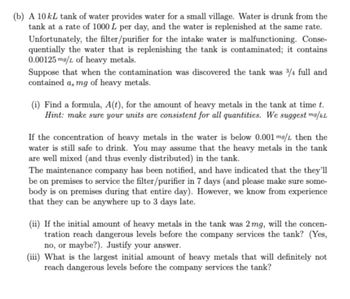

Step by stepSolved in 3 steps with 3 images

Step 1
Please explain how you can confirm 1.25mg of heavy metals are consumed per day? It seems to me that this is only true once the contamination of the tank reaches 0.00125m/L.
My thinking is this:
Assume the tank begins with a heavy metal concentration lower than 1.25mg/L.
Introducing 1kL of water with concentration 1.25mg/kL to a 7.5kL supply results in:
8.5kL of water, and 1.25mg of heavy metals
Therefore the supply's concentration = 1.25mg/8.5kL
And removing 1kL results in the tank having the same concentration (1.25mg/8.5kL). The question expects you to assume the tank is well mixed.
Also, I acknowledge that this thinking assumes that the contaminated water is all added before any water is removed, which is an incorrect assumption, but it just demonstrates where my confusion is.
Step 1
Please explain how you can confirm 1.25mg of heavy metals are consumed per day? It seems to me that this is only true once the contamination of the tank reaches 0.00125m/L.
My thinking is this:
Assume the tank begins with a heavy metal concentration lower than 1.25mg/L.
Introducing 1kL of water with concentration 1.25mg/kL to a 7.5kL supply results in:
8.5kL of water, and 1.25mg of heavy metals
Therefore the supply's concentration = 1.25mg/8.5kL
And removing 1kL results in the tank having the same concentration (1.25mg/8.5kL). The question expects you to assume the tank is well mixed.
Also, I acknowledge that this thinking assumes that the contaminated water is all added before any water is removed, which is an incorrect assumption, but it just demonstrates where my confusion is.
- 5. A patient initially has a concentration of 50mg/L of morphine in her blood and 70mg/L in her cerebrospinal fluid. Suppose that the drug moves into the cerebrospinal fluid at a per-capita rate of .4 and that the amount that is moved back from the cerebrospinal fluid to the bloodstream is .2. Suppose further that the metabolism of medicine in the bloodstream is .1 and the metabolism of the drug in the cerebrospinal fluid is .2 Blood cerebrospinal fluid ( brain ) Let x(t) represent the concentration in the blood and y(t) represent the concentration in the brain area. Finish this compartment diagram. Explain why this is a mathematical model for this process. dx = -.5x + .2y dt dy = .4x – 4y dt Solve for x(t) and y(t) given the initial conditions stated above. Simplify each expression as much as possible and write them in the blanks below. On the next page you must show all of your calculations. X(t)= Y(t)= .arrow_forwardNEEDED URGENTLY ....arrow_forwardSuppose A = 500(1.045)t . Compute dA/dtarrow_forward
- 3. A large tank with the capacity of 500 gallons is fully filled with pure water. Brine containing 2 pounds of salt per gallons is pumped into the tank at a rate of 5 gal/min. Find the amount A(t) pounds of salt in the tank at timer minutes, if the well-mixed solution is pumped out (a) with the same rate as the entering one; and (b) with the rate of 10 gal/min. In case (a), how much salt is in the tank after a long time? In case (b), what is the concentration of the solution in the tank by the time it is empty? (c) Let everything be the same except that, initially, the tank is filled with 250 gallons of pure water, while the well-stirred solution is pumped out with the flow rate of 2.5 gal/min. Find (t). What is the concentration of the solution in the tank by the time it is fully filled? Hint: (a) The volume of the solution in the tank at time (b) The volume of the solution in the tank at time minutes is V(t)= 500 gallons minutes is V(t)=500-5r gallons (c) The volume of the solution…arrow_forward5. Suppose that sodium pentobarbital is used to anesthetize a dog. The dog is anesthetized when its bloodstream contains at least 45 milligrams (mg) of sodium pentobarbitol per kilogram of the dog's body weight. Suppose also that sodium pentobarbitol is eliminated from the dog's bloodstream at a rate which is proportional to the amount of sodium pentobarbitol in the bloodstream and that after 5 hours half of the initially prescribed sodium pentobarbitol is elliminated from the bloodstream. Set up and solve an initial value differential equation. What single dose should be administered in order to anesthetize a 50-kg dog for 1 hr?arrow_forward
 Advanced Engineering MathematicsAdvanced MathISBN:9780470458365Author:Erwin KreyszigPublisher:Wiley, John & Sons, Incorporated
Advanced Engineering MathematicsAdvanced MathISBN:9780470458365Author:Erwin KreyszigPublisher:Wiley, John & Sons, Incorporated Numerical Methods for EngineersAdvanced MathISBN:9780073397924Author:Steven C. Chapra Dr., Raymond P. CanalePublisher:McGraw-Hill Education
Numerical Methods for EngineersAdvanced MathISBN:9780073397924Author:Steven C. Chapra Dr., Raymond P. CanalePublisher:McGraw-Hill Education Introductory Mathematics for Engineering Applicat...Advanced MathISBN:9781118141809Author:Nathan KlingbeilPublisher:WILEY
Introductory Mathematics for Engineering Applicat...Advanced MathISBN:9781118141809Author:Nathan KlingbeilPublisher:WILEY Mathematics For Machine TechnologyAdvanced MathISBN:9781337798310Author:Peterson, John.Publisher:Cengage Learning,
Mathematics For Machine TechnologyAdvanced MathISBN:9781337798310Author:Peterson, John.Publisher:Cengage Learning,






